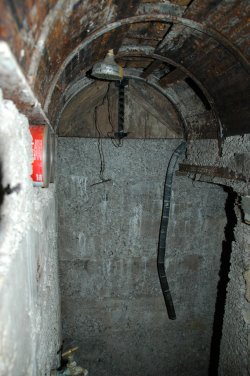
would probably provide adequate protection from the effects of initial nuclear radiation for people at about 1 mile from an air burst of a 1-megaton nuclear weapon. However, at this distance, the blast effect would be so great that only specially designed blast-resistant structures would survive.
The small shelter on the left, presently incomplete, is encased in armored concrete. On the right of the hanging cable which supplies electricity from some PV panels, a small opening enters a tunnel at the base of a mountain.
1.35 In the event of a moderately high (or high) air burst, the fission products remaining after the nuclear explosion will be dispersed in the atmosphere. The residual nuclear radiation arising from these products will be of minor immediate consequence on the ground. On the other hand, if the burst occurs nearer the earth's surface, the fission products may fuse with particles of earth, part of which will soon fall to the ground at points close to the explosion. This dirt and other debris will be contaminated with radioactive material and will, consequently, represent a possible danger to living things.
2.01 A number of characteristic phenomena, some of which are visible whereas others are not directly apparent, are associated with nuclear explosions. Certain aspects of these phenomena will depend on the type of burst, i.e., air, high altitude, surface, or subsurface, as indicated in chapter 1. This dependence arises
from direct and secondary interactions of the output of the exploding weapon with its environment, and leads to variations in the distribution of the energy released, particularly among blast, shock, and thermal radiation. In addition, the design of the weapon can also affect the energy distribution. Finally, meteorological conditions, such as temperature, humidity, wind, precipitation, and atmospheric pressure, and even the nature of the terrain over which the explosion occurs may influence some of the observed effects. Nevertheless, the gross phenomena associated with a particular type of nuclear explosion , namely, high altitude, air, surface, underwater, or underground, remain unchanged. It is such phenomena that are described in this chapter.
THE FIREBALL
2.03 As already seen, the fission of uranium (or plutonium) or the fusion of the isotopes of hydrogen in a nuclear weapon leads to the liberation of a large amount of energy in a very small period of time within a limited quantity of matter. As a result, the fission products, bomb casing, and other